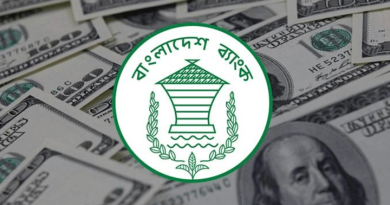July 17, 2025
Deposit growth in Bangladesh’s banking sector continued to lose momentum in May, despite many banks offering attractive interest rates to attract savers amid a persistent liquidity crunch.
According to the latest data from the Bangladesh Bank, the year-on-year growth in deposits stood at 7.73% at the end of May 2025, down from 8.21% in April and 8.51% in March. This marks a worrying trend, as deposit growth has remained below the double-digit threshold since September 2024.
As of May, the total deposit volume in the banking system rose to Tk 18.32 trillion, up from around Tk 17 trillion a year earlier. Yet, experts note that this growth is not keeping pace with economic needs or expectations.
High Interest Rates Fail to Attract Deposits
Despite banks offering interest rates ranging between 9% and 11%, and some troubled banks going as high as 13%, deposit mobilization remains sluggish. Financial sector insiders say the high yields on government treasury bills and bonds, which are currently offering 12.5%–13%, have diverted funds away from bank deposits.
“Many depositors prefer government securities over bank deposits due to better returns,” said Sheikh Mohammad Maroof, Managing Director of Dhaka Bank. “That is a key reason behind this trend.”
Inflation and Weak Business Sentiment Weigh on Savings
Economists attribute the slowdown to broader macroeconomic factors such as persistent inflation, limited private sector investment, and rising unemployment.
“Bangladesh has been facing elevated inflation for more than two and a half years,” said Dr. Zahid Hussain, former lead economist of the World Bank’s Dhaka office. “People’s incomes haven’t kept pace, reducing their capacity to save. With little left at the end of the month, deposit growth suffers.”
At the same time, weak business activity is also contributing to the situation. Private sector credit growth has remained under 8% for seven consecutive months, with May seeing just 7.17% growth in loan disbursement, down from 7.50% in April.
Tarek Reaz Khan, Managing Director of NRB Bank, echoed similar concerns, stating, “High inflation is eroding disposable income, leading to lower savings. If private and public sector businesses don’t expand, deposit growth will remain subdued.”
Central Bank Concerned by Slow Growth
Bangladesh Bank officials acknowledge the deceleration and are concerned. A senior official noted that, given the state of the economy, deposit growth should ideally exceed 10% to ensure adequate liquidity and support for lending.
Another central bank source added that rising unemployment is indirectly affecting the banking system, as fewer people earning wages means less money is entering the formal banking channel.
Meanwhile, Bangladesh Bank Governor Ahsan H. Mansur has pointed to dollar outflows and illicit capital flight as a key reason for money leaving the banking system. Speaking at various events in May, he said: “A large portion of funds is being laundered abroad, creating liquidity pressure in banks despite high deposit rates.”
Outlook
Unless inflation eases, business activity picks up, and consumer confidence improves, analysts believe deposit growth will remain subdued in the coming months — limiting banks’ capacity to lend and hindering broader economic recovery.






